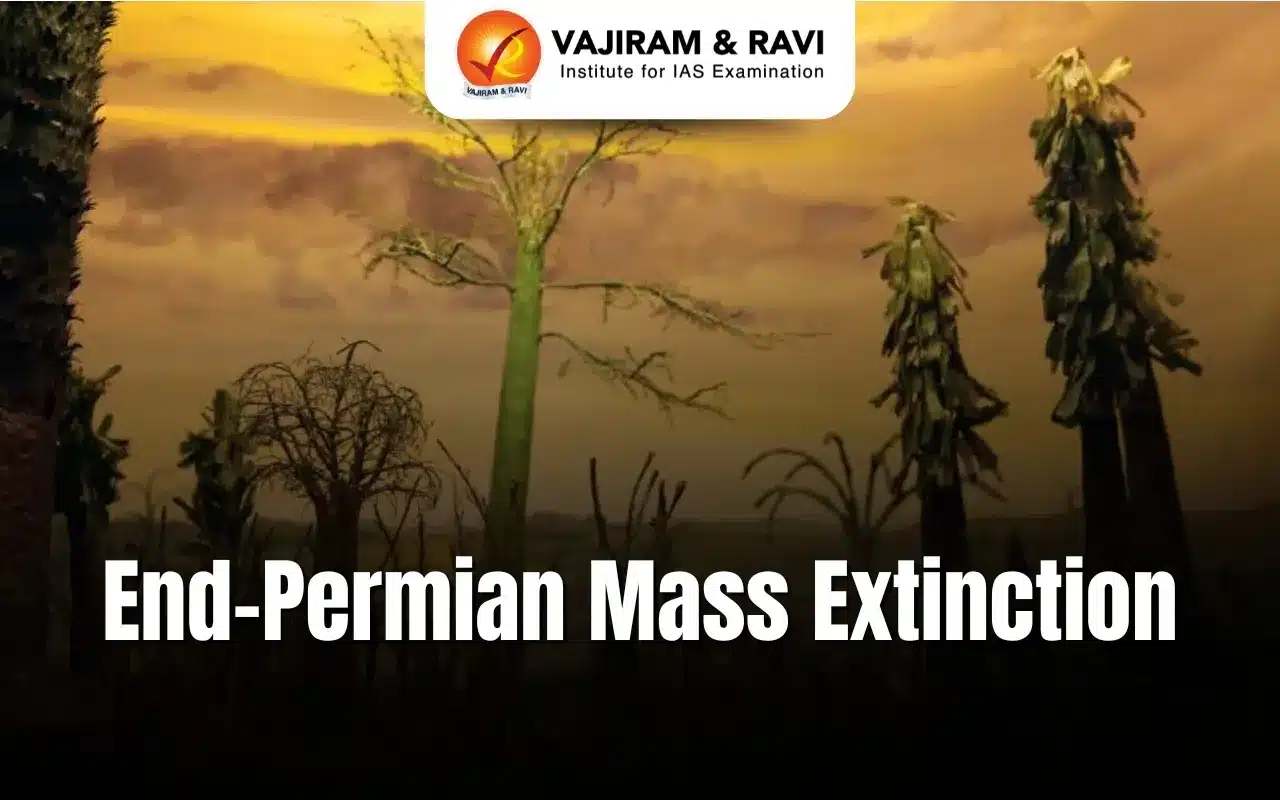End-Permian Mass Extinction Latest News
The End-Permian Mass Extinction that killed 80% of life on Earth 250 million years ago may not have been quite so disastrous for plants, new fossils hint.
About End-Permian Mass Extinction
- The End-Permian Mass Extinction (EPME), also known as the Permian-Triassic Extinction Event or “The Great Dying,” was the most severe extinction event in Earth’s history.
- It occurred approximately 252 million years ago and marked the transition from the Permian to the Triassic Period.
- The Triassic Period is the first period of the Mesozoic Era, lasting from 252 million to 201 million years ago.
End-Permian Mass Extinction Cause
- At that time, the supercontinent Pangea was in the process of breaking up, but all land on Earth was still largely clustered together, with the newly formed continents separated by shallow seas.
- An enormous eruption from a volcanic system called the Siberian Traps seems to have pushed carbon dioxide levels to extremes.
- The eruption covered around 2 million square kilometers with lava and wasone of the largest volcanic events in Earth’s history.
- The eruptions may have caused large amounts of carbon dioxide to be released into the atmosphere and caused a large-scale global warming effect of more than 10°C on land and around 8°C on the ocean surface in a short period of time.
- The eruptions may have also caused acid aerosols and dust clouds to be released into the atmosphere, which blocked out the sun and prevented photosynthesis from occurring, effectively causing many food chains to collapse.
- This caused global warming and ocean acidification, leading to a massive collapse of the ocean ecosystem.
End-Permian Mass Extinction Impacts
- EPME was characterized by the elimination of about 90 percent of the species on Earth, which included more than 95 percent of the marine species and 70 percent of the terrestrial species.
- In addition, more than half of all taxonomic families present at the time disappeared.
- It ranks first in severity among the five major extinction episodes that span geologic time.
End-Permian Mass Extinction FAQs
Q1. Which extinction killed the dinosaurs?
Ans. The extinction that killed the dinosaurs is called the Cretaceous-Paleogene (K-Pg) mass extinction, which occurred around 66 million years ago.
Q2. What was the worst mass extinction in history?
Ans. End-Permian Mass Extinction (EPME)
Q3. What is the oldest mass extinction?
Ans. The oldest mass extinction is the Ordovician-Silurian (O-S) extinction, which occurred around 443 million years ago.
Source: LS
Last updated on December, 2025
→ Check out the latest UPSC Syllabus 2026 here.
→ Join Vajiram & Ravi’s Interview Guidance Programme for expert help to crack your final UPSC stage.
→ UPSC Mains Result 2025 is now out.
→ UPSC Notification 2026 is scheduled to be released on January 14, 2026.
→ UPSC Calendar 2026 is released on 15th May, 2025.
→ The UPSC Vacancy 2025 were released 1129, out of which 979 were for UPSC CSE and remaining 150 are for UPSC IFoS.
→ UPSC Prelims 2026 will be conducted on 24th May, 2026 & UPSC Mains 2026 will be conducted on 21st August 2026.
→ The UPSC Selection Process is of 3 stages-Prelims, Mains and Interview.
→ UPSC Result 2024 is released with latest UPSC Marksheet 2024. Check Now!
→ UPSC Prelims Result 2025 is out now for the CSE held on 25 May 2025.
→ UPSC Toppers List 2024 is released now. Shakti Dubey is UPSC AIR 1 2024 Topper.
→ UPSC Prelims Question Paper 2025 and Unofficial Prelims Answer Key 2025 are available now.
→ UPSC Mains Question Paper 2025 is out for Essay, GS 1, 2, 3 & GS 4.
→ UPSC Mains Indian Language Question Paper 2025 is now out.
→ UPSC Mains Optional Question Paper 2025 is now out.
→ Also check Best IAS Coaching in Delhi

















